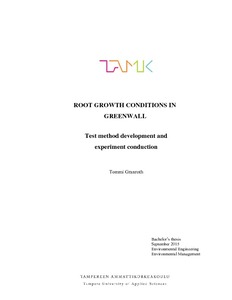Root Growth Conditions in Greenwall : Test Method Development and Experiment Conduction
Granroth, Tommi (2015)
Granroth, Tommi
Tampereen ammattikorkeakoulu
2015
All rights reserved
Julkaisun pysyvä osoite on
https://urn.fi/URN:NBN:fi:amk-2015100615164
https://urn.fi/URN:NBN:fi:amk-2015100615164
Tiivistelmä
The final thesis was a process and product development work done for NaturVention Oy. The aim of the thesis was to develop and validate a testing method for optimizing root growth conditions in a greenwall, and to provide relevant information of the effects of the chosen factors influencing the root growth. A set of testing equipment was designed and built to simulate the growing conditions in a NaturVention´s Naava -series greenwall. Two 3-4 weeks test periods were conducted during spring 2015, using Heart leaf philodendron due to it being considered as the most suitable species for the experiment. Root growth was measured by manually calculating the roots before and after the test periods.
The results of both test periods were thoroughly corrupted by root rot. Hence, profound data analysis could not be carried out and the test method could not be fully validated. However, based on the experiences gathered during the final thesis process the test method and test equipment can be developed to be more functional and reliable concerning further use.
The final thesis consists of a theory section, a section describing the conduction of the entire process, a section presenting the results, and a conclusive section where the process and results are discussed in detail and development suggestions are presented. Appendices and the contents of chapters 3 and 4 presenting the materials, methods and results are regarded as confidential information.
The results of both test periods were thoroughly corrupted by root rot. Hence, profound data analysis could not be carried out and the test method could not be fully validated. However, based on the experiences gathered during the final thesis process the test method and test equipment can be developed to be more functional and reliable concerning further use.
The final thesis consists of a theory section, a section describing the conduction of the entire process, a section presenting the results, and a conclusive section where the process and results are discussed in detail and development suggestions are presented. Appendices and the contents of chapters 3 and 4 presenting the materials, methods and results are regarded as confidential information.
